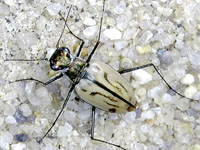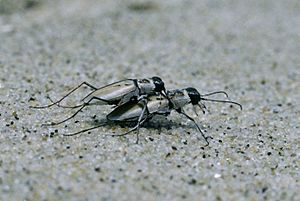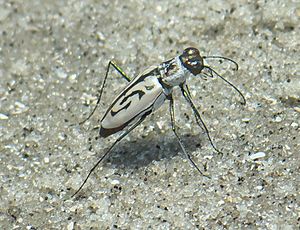Eastern beach tiger beetle facts for kids
Quick facts for kids Eastern beach tiger beetle |
|
|---|---|
 |
|
| Habroscelimorpha dorsalis dorsalis | |
| Conservation status | |
| Scientific classification | |
| Genus: |
Habroscelimorpha
|
| Species: |
dorsalis
|
| Synonyms | |
|
|
The eastern beach tiger beetle (scientific name: Habroscelimorpha dorsalis) is a super cool and speedy insect. It's a type of tiger beetle, known for being quick hunters. You can find these beetles in parts of Central America and North America, especially near sandy beaches. They belong to a big family of insects called ground beetles.
Contents
Meet the Eastern Beach Tiger Beetle
These beetles are about 13 to 15 millimeters long, which is roughly the size of a small paperclip. Their head and middle body part (called the thorax) are a shiny bronze-green color. They have long, thin legs, perfect for running fast!
Their wing covers, called elytra, are usually white or light tan with thin bronze marks. This light color helps the beetle blend in perfectly with the bright sand on the beach. Their head has long antennae, big eyes, and strong jaws for catching food. You might also notice white hairs on their upper body (the pronotum) and the sides of their belly (the abdomen).
Baby tiger beetles, called larvae, look a bit like grubs. They have long, segmented bodies and jaws similar to the adults.
The Northeastern Beach Tiger Beetle
One special type of this beetle is the Northeastern beach tiger beetle (Habroscelimorpha dorsalis dorsalis). It's the biggest kind of eastern beach tiger beetle. These beetles live along the northeastern coast of the United States. They dig small burrows in the sand to live in.
Sadly, these beetles are in danger. Lots of human activity on beaches and beach erosion (when the sand washes away) make it hard for them to survive. Because of this, the Northeastern beach tiger beetle was listed as "threatened" in 1990 under a law called the Endangered Species Act. It's the only type of eastern beach tiger beetle to be on this list.
Amazing Rolling Larvae
The larvae of another type, C. d. media, have an incredible trick! They can leap into the air, curl their bodies into a wheel, and roll along the sand super fast. They use the wind to help them move. If the wind is strong, a larva can roll up to 60 meters (about 200 feet)! Scientists think this amazing ability helps them escape from predators, like the thynnid wasp. Rolling like a wheel is very rare in nature, and only a few animals in the world can do it.
Different Kinds of Eastern Beach Tiger Beetles
There are four main types, or subspecies, of the eastern beach tiger beetle:
- Habroscelimorpha dorsalis dorsalis (Say, 1817)
- Habroscelimorpha dorsalis media (LeConte, 1856)
- Habroscelimorpha dorsalis saulcyi (Guérin-Méneville, 1840)
- Habroscelimorpha dorsalis venusta (LaFerte-Senectere, 1841)
Where They Live
Different types of these beetles live in different coastal areas. For example, H. d. media lives along the southeast coast of the United States, including South Carolina. The H. d. dorsalis lives along the northeast coast. Other types, C. d. saulcyi and C. d. venusta, are found along the coasts of Florida, the Gulf of Mexico, and Mexico.
Generally, eastern beach tiger beetles like wide, sandy beaches that are open to the ocean's tides and not too disturbed by people. For the beetles to have babies, the beaches need to be at least 100 meters (about 330 feet) long and 2 meters (about 6.5 feet) wide. They prefer warm weather, usually above 15°C (59°F), and a moderate amount of rain.
Life Cycle of the Beetle
The entire life of an eastern beach tiger beetle takes about two years. Adult beetles usually appear between mid-June and mid-August. They are most common in mid-July and start to disappear by September.
During warm, sunny days, they spend their time hunting for food in the intertidal zone. This is the part of the beach that is covered by water at high tide and exposed at low tide. They eat small invertebrates like flies, ants, and amphipods (tiny shrimp-like creatures). They will also eat dead fish and crabs they find.
Mating and Eggs
Mating happens between mid-July and early August when it's warm and humid. Female beetles lay their eggs in the intertidal zone. They use special hairs on their belly to check if the sand is wet enough for their babies to grow. The female lays her eggs at night. She uses a special part called an ovipositor to dig a small hole in the sand and lays each egg one by one.
Larval Stage
The eggs hatch in mid-August. The tiny larvae dig straight down into the sand, making vertical burrows. They hold themselves in place using hooks on their bodies. These larvae are also hunters, just like the adults! They wait in their burrows and grab any insects or small creatures that pass by.
Tiger beetle larvae grow through three stages, called instars. They usually reach the second stage by September. As winter gets close, the larvae dig new burrows higher up on the beach. This protects them from storms and big waves. After spending the winter in their burrows (this is called overwintering), they come out in late May and June. They then reach their third instar and overwinter again. The next spring, they change into a pupa (a resting stage) in their burrows. Finally, they emerge as full-grown adults!
Protecting the Beetles
The Northeastern beach tiger beetle (C. d. dorsalis) has faced a big drop in numbers over the last 20 years. It used to live all along the Atlantic coast of the USA, from Massachusetts to Virginia. Today, you can only find it in a few places, like the Chesapeake Bay in Maryland, Martha's Vineyard island in Massachusetts, and parts of Virginia.
This decline happened because their natural beach homes were destroyed or disturbed by human activities. One big problem is when people build hard structures like rip-rap (piles of rocks) along the shoreline. Other dangers include pollution and pesticides (chemicals used to kill pests). Also, off-road vehicles driving on the beach can crush adult beetles and larvae, and damage their burrows. In 2009, the United States Fish and Wildlife Service suggested that this beetle should be listed as "endangered," which means it's in even greater danger.




